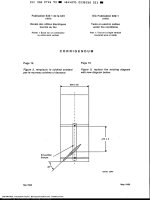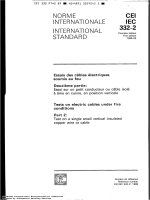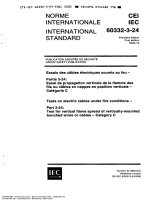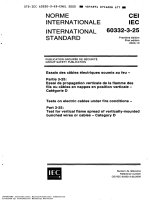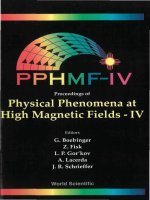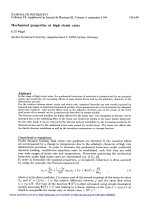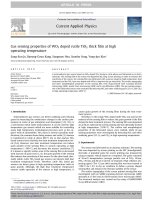Materials under extreme conditions molecular crystals at high pressure
Bạn đang xem bản rút gọn của tài liệu. Xem và tải ngay bản đầy đủ của tài liệu tại đây (4.96 MB, 373 trang )
www.pdfgrip.com
Materials Under
Extreme Conditions
Molecular Crystals at High Pressure
p603hc_9781848163058_tp.indd 1
29/5/13 9:20 AM
May 2, 2013
14:6
BC: 8831 - Probability and Statistical Theory
www.pdfgrip.com
This page intentionally left blank
PST˙ws
www.pdfgrip.com
Materials Under
Extreme Conditions
Molecular Crystals at High Pressure
Roberto Bini
•
Vincenzo Schettino
University of Florence, Italy
ICP
p603hc_9781848163058_tp.indd 2
Imperial College Press
29/5/13 9:20 AM
www.pdfgrip.com
Published by
Imperial College Press
57 Shelton Street
Covent Garden
London WC2H 9HE
Distributed by
World Scientific Publishing Co. Pte. Ltd.
5 Toh Tuck Link, Singapore 596224
USA office: 27 Warren Street, Suite 401-402, Hackensack, NJ 07601
UK office: 57 Shelton Street, Covent Garden, London WC2H 9HE
Library of Congress Cataloging-in-Publication Data
Schettino, Vincenzo.
Materials under extreme conditions : molecular crystals at high pressure / Vincenzo Schettino,
Roberto Bini, University of Florence, Italy.
pages cm
Includes bibliographical references and index.
ISBN 978-1-84816-305-8 (hardcover : alk. paper)
1. High pressure chemistry. 2. Materials at high pressures. 3. Molecular crystals. I. Bini,
Roberto (Chemist) II. Title.
QD538.S34 2014
548'.842--dc23
2013038985
British Library Cataloguing-in-Publication Data
A catalogue record for this book is available from the British Library
Copyright © 2014 by Imperial College Press
All rights reserved. This book, or parts thereof, may not be reproduced in any form or by any means,
electronic or mechanical, including photocopying, recording or any information storage and retrieval
system now known or to be invented, without written permission from the Publisher.
For photocopying of material in this volume, please pay a copying fee through the Copyright Clearance
Center, Inc., 222 Rosewood Drive, Danvers, MA 01923, USA. In this case permission to photocopy
is not required from the publisher.
In-house Editor: Darilyn Yap
Printed in Singapore
October 21, 2013
9:51
World Scientific Book - 9in x 6in
www.pdfgrip.com
Dedication
to Margherita, Martina and Stefania,
to Giulia and Anna Margherita
v
HP-Materials˙Bini˙Schettino*corr
May 2, 2013
14:6
BC: 8831 - Probability and Statistical Theory
www.pdfgrip.com
This page intentionally left blank
PST˙ws
October 21, 2013
9:51
World Scientific Book - 9in x 6in
HP-Materials˙Bini˙Schettino*corr
www.pdfgrip.com
Preface
The pressure variable and its effects on the structure and properties of
molecules and materials have played a role of primary importance in the
development of chemistry and to implement important chemical processes.
For example, one could mention the high-pressure synthesis of ammonia
from the elements as a starting point for the production of nitrogen-based
fertilizers. In more recent times we could mention the use of supercritical fluids, like water and carbon dioxide, as friendly solvents in green
chemistry processes. In these and in many other extensive applications
of high-pressure techniques in chemistry, interest has been generally confined to gas phase, liquids and solutions with pressures not exceeding 1
GPa. Higher pressure regimes, above 1 GPa, where most materials are in
the solid crystalline state, have prevalently been the province of solid state
physicists, material scientists, geochemists and geophysicists, and planetary
scientists. This can be surprising considering the large variety of chemical
phenomena observed in this pressure range. As a matter of fact, the study
of the behaviour of materials at very high pressures significantly overlaps
with findings and principles of fields like solid state chemistry, crystal engineering and supramolecular chemistry. From a fundamental point of view,
application of high pressures to a crystalline array of molecules produces
a fine-tuning of the intermolecular distances, orientations and conformations, parameters eligible as potential reaction coordinates. Therefore,
high-pressure experiments offer unique possibilities to study chemical reaction mechanisms in elemental materials in a greatly simplified chemical
environment. The molecular confinement realized at high pressures produces a substantial overlap of the electron distributions, disclosing new
information on fundamental atomic and molecular properties. Indeed, the
behaviour of molecules at high pressures can be quite different from what
vii
October 21, 2013
9:51
World Scientific Book - 9in x 6in
HP-Materials˙Bini˙Schettino*corr
www.pdfgrip.com
viii
Materials Under Extreme Conditions: Molecular Crystals at High Pressure
we are used to in normal laboratory practice, to such an extent that it has
been suggested that the periodic table of the elements, the basic tool of
a chemist, should be revisited as if the high pressure was adding a third
dimension to the table.
The purpose of this book has been to summarize and collect the nevertheless large body of chemical reactions that have been reported at very
high pressures on solid materials. The attention has been focused on the
physical chemistry of molecular crystals that are particularly sensitive to
an increase of pressure since the weakness of the intermolecular interactions
makes them highly compressible. Attempts have consequently been made
to outline similarities of chemical behaviour at high pressures depending
on similarities of the molecular structure and of the intermolecular interactions. It actually turns out that high-pressure chemical reactions in the solid
state are highly collective or aggregate events. It is the ambition of the authors that this tentative comprehensive presentation of ultrahigh-pressure
chemical phenomena can stimulate some novel interest in high-pressure science in the chemical community.
October 21, 2013
9:51
World Scientific Book - 9in x 6in
HP-Materials˙Bini˙Schettino*corr
www.pdfgrip.com
Foreword
In less than 20 years the study of the properties of molecular crystals under extreme conditions of pressure and temperature, has made formidable
progress, thanks to the use of several diffraction and spectroscopic methods.
These techniques, in combination with the diamond anvil cells, allowed us
to deal with samples of very small dimensions and to exploit their particular sensitivity to variations of interatomic distances and of bond lengths
and angles, the main molecular factors affected by variations of the unit
cell dimensions in molecular crystals.
Changes of temperature and pressure give rise to important physical effects, inducing phase transitions and even opening the road to new unknown
crystal structures stable only under extreme conditions. These changes,
however, affect not only the physical, but also the chemical properties of
molecular crystals or liquids, since they directly act on the conformational
structure of the molecular units, giving rise to a redistribution of their
internal energy. This is conveniently analysed considering that external
intensive parameters, such as temperature and pressure, shape the form of
the inter- and intramolecular potentials reducing both the interatomic and
intermolecular distances. Volume contraction thus forces the molecules to
explore higher regions of the repulsive parts of the potential to reach new
energy minima. This also increases the relative weight of higher terms in the
parametric expansion of the intermolecular potential, inducing important
changes in its anharmonic part.
Chemical reactivity changes due to the coupled effect of pressure and
temperature are actually the main concern of this book, to my knowledge
the first book dealing in-depth with ‘details of all aspects of chemical reactivity under extreme conditions. This book, which specifically addresses
the study of the position and intensity of vibrational bands in molecular
ix
October 21, 2013
9:51
World Scientific Book - 9in x 6in
HP-Materials˙Bini˙Schettino*corr
www.pdfgrip.com
x
Materials Under Extreme Conditions: Molecular Crystals at High Pressure
crystals under very high pressures and low temperatures, originates from
the merging of the theoretical competencies of Prof. Vincenzo Schettino, a
well-recognized expert of the theoretical treatment of the lattice dynamics
of molecular crystals, with the experimental skills and competencies of his
former student Roberto Bini, today one of the world’s leading experts in
high-pressure experiments.
The number of molecular crystals discussed in this book, mostly studied
in the Florence laboratory where the authors work, either to individuate
the full range of their phase transitions or to follow in time their reactivity,
is impressive. Some highlights can give the reader a sufficiently detailed
image of the approach that characterizes the research reported in the book
and can underline the high level of sophistication reached in the experimental collection of data, and in the theoretical interpretation of the results,
either in structural or in reaction rate experiments. These include detailed
investigations of the crystal structure and phase transitions from simple to
rather complex molecules, as well as a documented analysis of their reaction
rates in different types of reactions. As a simple but impressive example
of the deep interest of the authors in the application of high-pressure measurements to basic theoretical and experimental problems in the field, we
consider worth reporting the collection of data concerning the structural
changes occurring in crystals of the simplest molecular systems, diatomic
molecules, that configure the basic experimental and theoretical procedures
when extended to larger molecular systems.
In the case of solid nitrogen, the phase diagram shows a large variety of different structural arrangements in the unit cell and the increase
of pressure, starting from the well-known Pa3 structure stable at normal
pressure, leads progressively to the formation of new phases in which the
quadrupole-quadrupole interactions dominant at low pressure are progressively substituted by a full reorganization of the triple bond, ultimately
leading to polymeric non-molecular structures and eventually to a conductive polymorphic material. Of particular interest is the case of solid oxygen.
Molecular oxygen has an open shell configuration with two unpaired electrons and possesses a magnetic moment that adds magnetic interactions
to the intermolecular potential, making it basically different from that of
nitrogen. At high pressure a beautiful strongly red-coloured phase has
been obtained in which the oxygen molecules are coupled by π-π ∗ interactions in prismatic (O2 )4 in an orthorhombic unit cell, a structure consistent
with the vibrational spectra and confirmed by ab initio density functional
simulations. Even more impressive is the occurrence of as many as five
October 21, 2013
9:51
World Scientific Book - 9in x 6in
HP-Materials˙Bini˙Schettino*corr
www.pdfgrip.com
Foreword
xi
different structural phases occurring in the range up to 40 GPa for solid
carbon dioxide, all retaining a centrosymmetric structure. Above 2000 K
solid carbon dioxide decomposes into amorphous carbon including single
diamond-like crystallites. At pressures higher than 40 GPa carbon dioxide,
even at temperatures lower than 2000 K, gives rise to a number of polymeric forms with structures similar to those found in cristobalite, stishovite,
coesite and amorphous silica analogues.
At extremely high pressures inducing an increase of the electronic kinetic energy, molecular crystals respond either by the formation of metallic
states, by the decomposition into single atoms or into ionic structures, more
adequate to the extremely high packing. Metallization of solid hydrogen,
predicted as early as 1935, has been experimentally claimed only very recently and a number of metallic systems including oxygen, sulphur, iodine,
bromine, hydrogen sulphide and even some four or five atomic molecules,
have been realized in several laboratories.
More important for the theoretical understanding of the reaction rate
dependence on variations of the structural conformation is the extension
of the research to irreversible reactions induced by pressure such as the
polymerization reactions of unsaturated hydrocarbons as well as of aromatic
systems.
At normal pressure irreversible polymerization processes can be activated either by photons or by suitable catalysts. Pressure represents, however, an alternative activation technique to allow the molecules to overcome
the energy barrier that separates the reactants from the final polymeric
products. High pressure therefore offers a variety of possible reaction pathways not feasible under normal conditions since, in the multidimensional
potential surface, it can select specific channels not occurring at normal
pressure. The number of these new reaction channels is further amplified
by the synergy of the simultaneous application of high pressure and photoactivation procedures, that allows the system to explore additional reaction pathways not accessible without jumping over potential barriers in the
multidimensional energy surface. The collective nature of lattice phonon
propagation in crystal can further assist in propagating energy in the crystals in order to reach reaction active sites such as defects or dislocations
that can help in overcoming energy potential barriers.
One of the most interesting polymerization reactions is that of acetylene. In the crystal, the acetylene molecules are lined up with an optimal
orientation for a topochemical addition to trans polyacetylene and in fact
at high pressure and in the absence of irradiation, pure trans polyacetylene
October 21, 2013
9:51
World Scientific Book - 9in x 6in
HP-Materials˙Bini˙Schettino*corr
www.pdfgrip.com
xii
Materials Under Extreme Conditions: Molecular Crystals at High Pressure
is obtained with complete delocalization of the π electron system. Irradiation with laser light gives origin to the production of gauche kinks whose
relative abundance increases by increasing the pressure.
Very important for practical applications is the polymerization of ethylene to produce both cis and trans polyethylene polymers in which the ratio
of the two forms depends sensibly on the pressure.
More complex is the behaviour under pressure of butadiene that, depending upon the reaction conditions, can produce either polybutadiene
through an ionic mechanism which favours the growth of a linear polymer
or even vinylcyclohexene through a multistep dimerization procedure.
Polymerizations of aromatic hydrocarbons build a series of very complex
reactions, owing to the weakly intermolecular forces binding the molecules
in the crystal structures, giving rise to a large number of different crystalline phases stable under high pressure. The phase diagrams of several
aromatic and hetero-aromatic hydrocarbons including even furane, thiophene, indole and similar molecules have been studied either to follow their
polymerization or their ring opening reactions. Here we shall only consider
the most studied compound of the series, crystalline benzene, just to give
an idea of the broad range of interests of the authors of the book. In the
case of benzene at extreme high pressure, amorphous hydrogenated carbon
material is obtained.
The large variety of interests that characterizes the present book makes
it an invaluable instrument for young researchers interested in the behaviour
of matter under extreme conditions and an indispensable support to those,
chemists, physicists, as well as geologists and mineralogists, interested in
the study of crystalline phases and in the comprehension of the structural
parameters and intermolecular potentials that make molecular crystals a
unique form of solid matter.
Salvatore Califano
Professor Emeritus
University of Florence
October 21, 2013
9:51
World Scientific Book - 9in x 6in
HP-Materials˙Bini˙Schettino*corr
www.pdfgrip.com
Acknowledgments
We would like to thank Professor Salvatore Califano for carefully reading
the manuscript and for his encouragement and suggestions.
We would like to express our special thanks to the researchers, postdocs
and students that during the last ten years followed, with an enthusiastic
daily dedication, the research topics at the basis of the present book. A
special acknowledgement goes to M. Ceppatelli, M. Citroni, F.A. Gorelli
and M. Santoro who have been protagonists of the scientific and technical
achievements which constitute the backbone of this book and were also able
to create a unique human environment.
xiii
May 2, 2013
14:6
BC: 8831 - Probability and Statistical Theory
www.pdfgrip.com
This page intentionally left blank
PST˙ws
October 21, 2013
9:51
World Scientific Book - 9in x 6in
HP-Materials˙Bini˙Schettino*corr
www.pdfgrip.com
Contents
Preface
vii
Foreword
ix
Acknowledgments
xiii
1. Introduction
1
2. Historical Survey
15
3. Elasticity and Equation of State
23
3.1
3.2
3.3
Stress and strain . . . . . . . . . . . . . . . . . . . .
Elasticity and anisotropy in molecular crystals . . .
3.2.1 Elastic constants . . . . . . . . . . . . . . . .
3.2.2 Temperature and pressure dependence of the
elastic constants . . . . . . . . . . . . . . . .
3.2.3 Single crystals and polycrystals . . . . . . .
3.2.4 Variation of crystal parameters with pressure
Parametric equations of state . . . . . . . . . . . . .
. . .
. . .
. . .
24
31
31
.
.
.
.
47
53
55
70
.
.
.
.
4. High-pressure Technical Survey
4.1
4.2
4.3
4.4
.
.
.
.
79
The piston-cylinder device . . . . . .
4.1.1 Large volume piston-cylinder
The opposed anvil devices . . . . . .
Multi-anvil devices . . . . . . . . . .
The diamond anvil cell . . . . . . . .
4.4.1 Diamonds . . . . . . . . . .
xv
. . . . . .
apparatus
. . . . . .
. . . . . .
. . . . . .
. . . . . .
.
.
.
.
.
.
.
.
.
.
.
.
.
.
.
.
.
.
.
.
.
.
.
.
.
.
.
.
.
.
. 80
. 85
. 86
. 89
. 93
. 102
October 21, 2013
9:51
World Scientific Book - 9in x 6in
HP-Materials˙Bini˙Schettino*corr
www.pdfgrip.com
xvi
Materials Under Extreme Conditions: Molecular Crystals at High Pressure
4.5
4.6
4.7
4.4.2 Gasket . . . . . . . . . . . . . . . . . . . . . .
4.4.3 Loading techniques . . . . . . . . . . . . . . .
4.4.4 Compression media . . . . . . . . . . . . . . .
High- and low-temperature techniques . . . . . . . . .
4.5.1 Low-temperature devices . . . . . . . . . . . .
4.5.2 Resistive heating . . . . . . . . . . . . . . . . .
4.5.3 Laser heating . . . . . . . . . . . . . . . . . .
Pressure measurement . . . . . . . . . . . . . . . . . .
Probing techniques based on electromagnetic radiation
4.7.1 Optical spectroscopy . . . . . . . . . . . . . .
4.7.2 X-ray diffraction . . . . . . . . . . . . . . . . .
4.7.3 Neutron diffraction . . . . . . . . . . . . . . .
4.7.4 Nuclear magnetic resonance . . . . . . . . . .
.
.
.
.
.
.
.
.
.
.
.
.
.
.
.
.
.
.
.
.
.
.
.
.
.
.
5. Principles of Chemical Reactivity Under Pressure
5.1
5.2
5.3
5.4
Pressure effects on chemical equilibria .
Pressure effects on reaction rates . . . .
Environmental effects at high pressure .
Effects of high pressure on the electronic
. . . . . .
. . . . . .
. . . . . .
structure
159
.
.
.
.
.
.
.
.
.
.
.
.
.
.
.
.
6. Chemical Reactions in Molecular Crystals
6.1
6.2
109
113
116
118
119
121
123
128
140
141
149
155
157
Reversible reactions . . . . . . . . . . . . . . . . . . .
6.1.1 Solid nitrogen at high pressure: the archetypal
energetic material . . . . . . . . . . . . . . . .
6.1.2 Red oxygen . . . . . . . . . . . . . . . . . . . .
6.1.3 Carbon dioxide: a multiform solid . . . . . . .
6.1.4 Formic acid . . . . . . . . . . . . . . . . . . .
6.1.5 Sulphur. Polymeric and molecular phases . . .
6.1.6 Symmetry breaking and ionization at
high pressures . . . . . . . . . . . . . . . . . .
6.1.7 Metallization at high pressures . . . . . . . . .
Irreversible reactions . . . . . . . . . . . . . . . . . . .
6.2.1 Unsaturated hydrocarbons . . . . . . . . . . .
6.2.2 Aromatics and heteroaromatics . . . . . . . .
6.2.3 Miscellanea . . . . . . . . . . . . . . . . . . . .
6.2.4 Energetic materials . . . . . . . . . . . . . . .
6.2.5 Photochemistry at high pressures . . . . . . .
160
165
177
185
193
. . 196
.
.
.
.
.
.
.
.
.
.
196
201
203
208
209
.
.
.
.
.
.
.
.
.
.
.
.
.
.
.
.
211
214
217
218
225
232
241
245
October 21, 2013
9:51
World Scientific Book - 9in x 6in
HP-Materials˙Bini˙Schettino*corr
www.pdfgrip.com
Contents
xvii
Bibliography
261
Appendix A
327
Index
349
May 2, 2013
14:6
BC: 8831 - Probability and Statistical Theory
www.pdfgrip.com
This page intentionally left blank
PST˙ws
October 21, 2013
9:51
World Scientific Book - 9in x 6in
HP-Materials˙Bini˙Schettino*corr
www.pdfgrip.com
Chapter 1
Introduction
All physical and chemical transformations are controlled by the thermodynamical variables of temperature, pressure and chemical potential [1].
Acting on these external or internal parameters it is possible to affect the
equilibrium composition of the systems and the kinetics of the transformation. The practical and theoretical implications of controlling the physical
and chemical processes are evident. In the interest of the present book we
shall confine the discussion to the effects of temperature and pressure and,
without much loss of generality, we shall refer mainly to chemical processes.
Changing the temperature of a system by exchange of heat with the
environment has a double effect. On one side there will be a change of
the internal energy of the system, with the excess energy redistributed
among the internal vibrational degrees of freedom and the translational
and rotational motions of the molecules, the latter two corresponding to
acoustic and librational phonons in crystalline systems. When the system is
composed of complex or flexible molecules a conformational reorganization
can also be induced by a temperature change. A redistribution of the excess
internal energy in the electronic energy levels is not of much interest for
the systems and the conditions considered in the present book. A change
of temperature also produces a change of volume of the system by the
effect of the anharmonicity of the interaction potential. On the contrary,
the exchange of mechanical energy by an isothermal change of the external
pressure applied to the system will result in a mere change of volume.
It is therefore seen that changes of temperature or pressure both have the
common primary effect of a volume dilatation or compression of the system.
Decreasing the volume of the system by lowering the temperature or by
increasing the pressure produces a shortening of the interatomic and intermolecular distances. The effect of a volume contraction on the structure of
1
October 21, 2013
9:51
World Scientific Book - 9in x 6in
HP-Materials˙Bini˙Schettino*corr
www.pdfgrip.com
2
Materials Under Extreme Conditions: Molecular Crystals at High Pressure
the system can be qualitatively viewed in different converging ways. Our
attention will be focused on molecular systems which, even at moderate
pressures, are found in the crystalline state. As usually, the intermolecular
interaction potential can be decomposed in an attractive and in a repulsive
component [2–6]. In molecular crystals and in the absence of, or neglecting, electrostatic interactions that have a slower decay with separation,
the attractive part of the interaction potential mainly arises from London
dispersion forces and typically depends on the inverse sixth power of the
intermolecular distance r. The repulsive part of the interaction potential
substantially arises from electron overlap and from electron-electron correlation and typically depends on the inverse 12th power of the intermolecular
separation. This is the form of the Lennard-Jones potential [5–10],
E = 4ǫ −
r
σ
−6
+
r
σ
−12
(1.1)
where ǫ is the value of the energy minimum at equilibrium and σ is the
finite intermolecular distance at which the repulsive and attractive terms
are equal (and opposite in sign).
In Figure 1.1 the Lennard-Jones potential for argon is shown with the
following values of the parameters kǫ = 119.8 K and σ = 3.405 ˚
A [2]. It can
easily be seen that decreasing the intermolecular distance below the equilibrium configuration, the repulsive energy rapidly increases and otherwise
inaccessible regions of the potential energy surface are explored. Therefore,
the system enters a region of possible electronic instability and a structural
reorganization can be expected. We must expand our considerations beyond
the description of the system as governed by purely central forces, as it is
actually the case for the molecular crystals which are the main object of our
treatment and, as it will be discussed in a following chapter, can be highly
anisotropic as a consequence of both the intrinsic molecular shape and the
type of intermolecular interactions (van der Waals, electrostatic, hydrogen
bonding). The search for a new energy minimum can be pursued by a reorientation of the molecules in the crystal structure, by phase transitions
of different types [10] and, at higher reduced volumes, by a reorganization
of the general bonding structure through chemical reactions. The effects
of a volume contraction on the electronic structure can best be considered
from the point of view of the density functional theory [11]. In the limit of
the electron gas behaviour the repulsive electron-electron interaction varies
with density ρ as ρ2/3 (or in the isotropic case as r−2 ) while the attractive
electron-nuclei interaction varies as ρ1/3 (or as r−1 in the isotropic case).
October 21, 2013
9:51
World Scientific Book - 9in x 6in
HP-Materials˙Bini˙Schettino*corr
www.pdfgrip.com
3
Introduction
3
u(r) / ε
2
1
0
-1
-2
0
0.5
1
1.5
2
2.5
3
r/σ
Fig. 1.1 Lennard-Jones potential of argon showing separately the attractive (dash dot)
and repulsive (dash) contributions.
Also within this approach it is seen that at reduced volumes the repulsive
electron-electron energy increases more rapidly and finally becomes equal to
the attractive terms, thus leading to possible transformations and chemical
reactions allowing the system to reach a new energy minimum.
The types of transformations that can be induced in a molecular system by a decrease of volume, and specifically by increasing the pressure,
have been discussed by Drickamer and Frank [12, 13] who consider the four
types of transformation listed in Table 1.1 occurring at increasing volume
contraction. The boundaries between the different types of transitions considered in Table 1.1 are rather loosely defined. To some extent a change of
the electronic configuration may occur in all cases of volume reduction, but
the extent of reorganization can be substantial only at higher compressions
when the electron overlap can lead to changes of configuration interaction
resulting in new ground and excited states. This situation is of specific
interest in the present work which has the purpose of discussing molecular
crystals and other molecular aggregates that, when subjected to high pressures, exhibit a chemical behaviour associated with structural changes that
can be drastically different from the known or expected behaviour under
normal conditions.
October 21, 2013
9:51
World Scientific Book - 9in x 6in
HP-Materials˙Bini˙Schettino*corr
www.pdfgrip.com
4
Materials Under Extreme Conditions: Molecular Crystals at High Pressure
Table 1.1 Transitions occurring in molecular systems at increasing
volume contraction
Type
I
II
III
IV
Atomic rearrangements (e.g. reorientation of molecules)
Polymorphism, Phase transitions
Discontinuous electronic transitions, Structural changes
Continuous electronic transitions, New reactive ground state
Following Drickamer [12, 13], the changes of the electronic structure
occurring at reduced volumes can be schematically described considering
a two-level system where the ground and excited states can be considered as representative of the HOMO (Highest Occupied Molecular Orbital)
and LUMO (Lowest Unoccupied Molecular Orbital) molecular orbitals in
a molecular system. The changes are represented in Figure 1.2 where, on
the left side, the potential energy curves at the initial volume V0 are shown
while, on the right, the energy curves at the reduced volume V are depicted.
For the present purposes the electronic structure can be characterized by
the vertical (Franck–Condon) excitation energies E0 and E0′ , by the ther′
mal excitation energies Eth and Eth
and by the differences between the
′
ground and excited state geometries ∆ = Re − R0 and ∆ = Re′ − R0′ . The
basic structural change R0′ − R0 is also of great relevance. The diagram
of Figure 1.2 is oversimplified. In general, we shall be dealing with multidimensional energy surfaces. In addition, it has been assumed that the
energy surfaces are purely quadratic thus neglecting the important role of
Fig. 1.2 Evolution of the electronic structure as a function of the volume of the system.
Left: electronic structure at the initial volume V0 ; right: electronic structure at the
reduced volume V.
October 21, 2013
9:51
World Scientific Book - 9in x 6in
HP-Materials˙Bini˙Schettino*corr
www.pdfgrip.com
Introduction
5
anharmonicity. More elaborate models of the pressure effects on electronic
states have been discussed [14–18]. Nevertheless, the experimentally observed essential features of the problem can be captured from the figure.
It has been reported that the frequency of the electronic transitions shows
a small red shift on pressurization (i.e., E0′ < E0 ) and, in addition, there
is a general broadening of the absorption (and emission) lines. Nevertheless, as it can be appreciated from the figure, the thermal excitation energy
can considerably lower and a significant population of the excited state can
occur even at room temperature. This gives rise at high pressures to a
reduction (or even a cancellation) of the HOMO-LUMO gap as it is actually represented in the figure and can have important consequences on the
high-pressure mechanisms of chemical reactions as will be discussed in the
following chapters. Another important feature emerging from the figure is
that at highly reduced volumes the structures of the ground and excited
states could become very similar, if not coincident, and that some energy
barriers can reduce to a significant extent.
All the above considerations apply to any volume reduction of the system independent of its origin. However, there are in practice significant
differences in the effects that can be induced by a temperature decrease or
by an increase of pressure (or by a change in composition). To illustrate the
point, let us consider a typical molecular crystal composed of rigid molecular units held together by weak van der Waals interactions like the C60
fullerene crystal [19]. Figure 1.3 shows the evolution of the cubic unit cell
parameter as a function of temperature from 0 to 360 K. This is a pretty
large temperature interval for most molecular crystals before melting or
thermal decomposition. It can be seen from the figure that in this ample temperature interval, a volume variation of only 3–4% occurs despite
the fact that molecular crystals are rather soft in view of the weakness
of the intermolecular interactions. The same systems (molecular crystals)
can be subjected, before decomposition, to a much larger volume variation
by application of an external pressure. As an example in Figure 1.4 the
isothermal equation of state of solid methane at 300 K is reported for a
compression up to 210 GPa [20]. In the first instance, the figure demonstrates the extraordinary stability of methane to compression, a fact that
is of relevance to the physics of the extraterrestrial giant planets Neptune
and Uranus [21]. In the ample pressure range shown in the figure, methane
is stable and experiences a unit cell volume variation from 590 to 250 A3 .
At such a large volume contraction (V /V0 = 0.42) the shortening of interatomic distances is substantial, the electronic structure is expected to
October 21, 2013
9:51
World Scientific Book - 9in x 6in
HP-Materials˙Bini˙Schettino*corr
www.pdfgrip.com
6
Materials Under Extreme Conditions: Molecular Crystals at High Pressure
Lattice parameter (angstrom)
14.15
14.10
14.05
0
50
100
150
200
250
300
350
T (K)
Fig. 1.3 Variation with temperature of the cubic unit cell parameter of fullerene (readapted from I. F. David, et al. Europhys. Lett. 18 (1992) 219, Copyright (1992), with
permission from IOP).
change significantly and the chemical behaviour can be completely different than under normal conditions. It is therefore seen that acting on the
pressure variable, volume variations can be explored in much greater detail.
The same point can be stated in a different way considering, for instance,
the variation of the free energy induced in the CsI crystal by feasible variations of the temperature and external pressure [22]. This is shown in Figure
1.5. It can be seen that by tuning the pressure, a much more extended region of the free energy surface can actually be explored than by changing
the temperature.
The Gibbs free energy increase occurring at high pressures is mainly
due to the PV term of the free energy,
G = E + P V − T S.
(1.2)
As an example, in Table 1.2 the variation of the PV term of the free energy of some typical molecular crystals ( methane [20], benzene [23], nitromethane [24] and acetaminophen [25]) subjected to pressurization in

